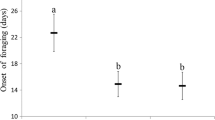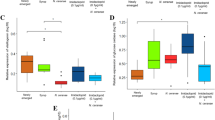Abstract
Western honey bees (Apis mellifera) are under threat from a number of emerging pathogens, including the microsporidian Nosema ceranae historically of Asian honey bees (Apis cerana). Because of its recent detection, very little is known about the biology, pathology, and control of N. ceranae in western honey bees. Here we investigated effects of the antibiotic Fumagilin-B®, which is commonly used to control the historical Nosema parasite of western honey bees Nosema apis, on N. ceranae and effects of N. ceranae on colony strength (i.e., number of bees and amount of capped and uncapped brood, honey, and pollen) and colony mortality. Similar to our previous study, fall Fumagilin-B® treatment lowered, albeit weakly, N. ceranae intensity the following spring. However, N. ceranae was not associated with variation in colony strength measures or with higher colony winter mortality.
Similar content being viewed by others
References
Bailey L. (1957) Comb fumigation for Nosema disease, Am. Bee J. 97, 24–26.
Cantwell G.E. (1970) Standard methods for counting Nosema spores, Am. Bee J. 110, 222–223.
Cantwell G.E., Shimanuki H. (1969) Heat treatment as a means of eliminating Nosema and increasing production, Am. Bee J. 109, 52–54.
Chen Y., Evans J.D., Smith I.B., Pettis J.S. (2008) Nosema ceranae is a long-present and widespread microsporidian infection of the European honey bee (Apis mellifera) in the United States, J. Invertebr. Pathol. 97, 186–188.
Europa (2009) Residues of Veterinary Medicinal Products-Third Countries. Available from http://ec.europa.eu/food/food/chemicalsafety/residues/third_countries_en.htm (accessed 31 December 2009).
Fries I. (1988) Comb replacement and Nosema disease (Nosema apis Z.) in honey bee colonies, Apidologie 19, 343–354.
Fries I. (2009) Nosema ceranae in European honey bees (Apis mellifera), J. Invertebr. Pathol. 103, S73–S79.
Fries I., Ekbohm G., Villumstad E. (1984) Nosema apis, sampling techniques and honey yield, J. Apic. Res. 23, 102–105.
Gochnauer T.A., Fugala B. (1969) Chemotherapy of Nosema disease: compatability of fumagillin with other chemicals, Am. Bee J. 109, 309–311.
Higes M., García-Palencia P., Martín-Hernández R., Meana A. (2007) Experimental infection of Apis mellifera honeybees with Nosema ceranae (Microsporidia), J. Invertebr. Pathol. 94, 211–217.
Higes M., Martín R., Meana A. (2006) Nosema ceranae, a new microsporidian parasite in honeybees in Europe, J. Invertebr. Pathol. 92, 93–95.
Higes M., Martín-Hernández R., Botías C., Bailón E.G., González-Porto A.V., Barrios L., del Nozal M.J., Bernal J.L., Jiménez J.J., Palencia P.G., Meana A. (2008) How natural infection by Nosema ceranae causes honey bee colony collapse, Environ. Microbiol. 10, 2659–2669.
Huang W.-F., Jiang J.-H., Chen Y.-W., Wang C.-H. (2007) A Nosema ceranae isolate from the honeybee Apis mellifera, Apidologie 38, 30–37.
Klee J., Besana A.M., Genersch E., Gisder S., Nanetti A., Tam D.Q., Chinh T.X., Puerta F., Ruz J.M., Kryger P., Message D., Hatjina F., Korpela S., Fries I., Paxton R.J. (2007) Widespread dispersal of the microsporidian Nosema ceranae, an emergent pathogen of the western honey bee, Apis mellifera, J. Invertebr. Pathol. 96, 1–10.
Martín-Hernández R., Meana A., Prieto L., Salvador A.M., Garrido-Bailon E., Higes M. (2007) Outcome of colonization of Apis mellifera by Nosema ceranae, Appl. Environ. Microbiol. 73, 6331–6338.
Paxton R.J., Klee J., Korpela S., Fries I. (2007) Nosema ceranae has infected Apis mellifera in Europe since at least 1998 and may be more virulent than Nosema apis, Apidologie 38, 558–565.
Pickard R.S., El-Shemy A.A.M. (1989) Seasonal variation in the infection of honeybee colonies with Nosema apis Zander, J. Apic. Res. 28, 93–100.
Rogers R.E.L., Williams G.R. (2007) Monitoring Nosema disease in honey bee colonies, Bee Culture 135, 19–21.
Shafer A.B.A., Williams G.R., Shutler D., Rogers R.E.L., Stewart D.T. (2009) Cophylogeny of Nosema (Microsporidia: Nosematidae) and bees (Hymenoptera: Apidae) suggests both cospeciation and a host-switch, J. Parasitol. 95, 198–203.
Szabo T.I., Heikel D.T. (1987) Effect of fumagillin treatment on Nosema infection, survival, and populations of overwintering honeybee colonies, J. Apic. Res. 26, 186–190.
van Engelsdorp D., Evans J.D., Saegerman C., Mullin C., Haubruge E., Nguyen B.K., Frazier M., Frazier J., Cox-Foster D., Chen Y., Underwood R., Tarpy D.R., Pettis J.S. (2009) Colony collapse disorder: a descriptive study, PLoS One 4, e6481–e6497.
Whittington R., Winston M.L. (2003) Effects of Nosema bombi and its treatment fumagillin on bumble bee (Bombus occidentalis) colonies, J. Invertebr. Pathol. 84, 54–58.
Williams G.R., Sampson M.A., Shutler D., Rogers R.E.L. (2008b) Does fumagillin control the recently-detected invasive parasite Nosema ceranae in western honey bees (Apis mellifera)? J. Invertebr. Pathol. 99, 342–344.
Williams G.R., Shafer A.B.A., Rogers R.E.L., Shutler D., Stewart D.T. (2008a) First detection of Nosema ceranae, a microsporidian parasite of European honey bees (Apis mellifera), in Canada and central USA, J. Invertebr. Pathol. 97, 189–192.
Williams G.R., Shutler D., Rogers R.E.L. (2010) Effects at Neartic north-temperate latitudes of indoor versus outdoor overwintering on the microsporidium Nosema ceranae and western honey bees (Apis mellifera), J. Invertebr. Pathol. 104, 4–7.
Author information
Authors and Affiliations
Corresponding author
Additional information
Manuscript editor: Peter Rosenkranz
Rights and permissions
About this article
Cite this article
Williams, G.R., Shutler, D., Little, C.M. et al. The microsporidian Nosema ceranae, the antibiotic Fumagilin-B®, and western honey bee (Apis mellifera) colony strength. Apidologie 42, 15–22 (2011). https://doi.org/10.1051/apido/2010030
Received:
Revised:
Accepted:
Published:
Issue Date:
DOI: https://doi.org/10.1051/apido/2010030




